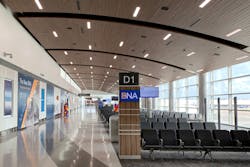Sustainable Design Takes Flight at Nashville International Airport’s New Concourse D
Fentress Architects announced that the new Concourse D at Nashville International Airport (or BNA, as it is also known) has achieved LEED Silver certification, highlighting the project’s sustainable, wellness-oriented design and construction process. This distinction makes Concourse D one of only five newly constructed airport facilities in the United States, and one of nine airport facilities worldwide, to earn LEED Silver under the U.S. Green Building Council’s (USGBC) rigorous LEED v4 standards.
LEED, or Leadership in Energy and Environmental Design, is the most widely used green building rating system in the world and an international symbol of excellence. LEED v4’s flexible, performance-based approach and progressive sustainability benchmarks are designed to optimize building performance and support occupant health and wellbeing.
“Fentress Architects has been at the forefront of green building design for over four decades,” said Curtis Fentress, FAIA, RIBA, Principal in Charge of Design at Fentress Architects. “Energy conservation is a key element of not only our design approach, but our values as a firm. We are proud to have leveraged our expertise, along with the commitment of all partners involved in this significant project, to realize BNA’s forward-thinking sustainability standards.”
The Hensel Phelps Fentress Architects Progressive Design-Build Team completed the $292 million, 115,000 square-foot expansion of Concourse D in July, marking a major milestone for BNA Vision — the dynamic expansion and renovation plan for Nashville International Airport. The project elevates the airport as a world-class facility with six domestic aircraft gates, public art, diverse traveler amenities, and improved ramp amenities and function space.
“LEED certification is a coveted mark of environmental distinction and innovation,” said BNA President and CEO Doug Kreulen. “We’re building not only a bigger airport, but also a better, ‘greener,’ more sustainable airport. I’m proud of our commitment to these principles and appreciative of all the hard work that went into obtaining this recognition.”
The project team’s integrative and passenger-centric approach incorporated several green design and construction components to optimize building performance and passenger comfort while minimizing environmental impacts, including:
- Electrochromic glass that blocks out excessive sunlight and heat for passengers’ comfort while reducing glare and energy consumption for climate control;
- Energy-efficient and programmable lighting that dims when natural light is adequate for visibility;
- Focus on human health and wellness with features including an abundance of daylighting, green cleaning practices, water bottle filling stations, public art installations, and more;
- Light-colored building and paving materials that retain less heat, reducing energy use while mitigating heat-island effect;
- Geothermal cooling reduces energy consumption and costs for climate control;
- Water-conserving plumbing; and
- Waste-reduction focus with recycling bins throughout the concourse and 80 percent of construction waste diverted from landfills.
Other key project partners include Corgan (master architect for BNA Vision), I.C. Thomasson Associates Inc. (mechanical, electrical and plumbing engineer), Smith Seckman Reid Inc. (commissioning agent), and S&ME (civil engineer/landscape designer).
“At every stage of the project, from the design process to construction, the project team remained committed to aligning our approach with the airport’s sustainability targets,” said Deborah Lucking, AIA, LEED AP BD+C, Director of Sustainability at Fentress Architects. “Fentress is committed to advancing sustainability and human wellness in the built environment and achieving LEED v4 Silver showcases the project team’s dedication to going far beyond the minimum LEED requirements to achieve certification.”

